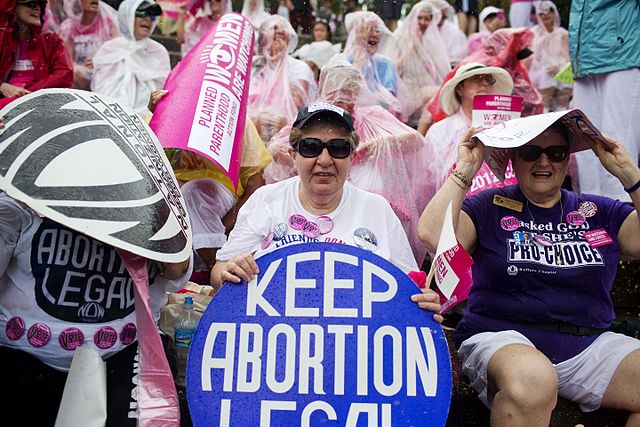By: Mackenzie Rice*
On Monday, January 23rd 2017, President Donald Trump signed an executive order that would enforce a policy known as the Global Gag Rule. This policy means that international organizations that perform legal abortion services, promote the legalization of safe abortions, educate the public and governments about the importance of accessible abortion services, or simply offer women advice on where to seek a safe and legal abortion will no longer receive federal funding from the United States.[1] While pro-life and pro-choice supporters alike in the United States took this executive order as an opportunity to express their views for and against a woman’s right to choose, focusing on the domestic response to what was deemed President Trump’s first pro-life action would cause us to overlook the dire implications that the Global Gag Rule can have internationally on gender equality and sustainable development.
While the Global Gag Rule is designed as a specifically anti-abortion policy, it also negatively impacts the ability for international organizations to provide a broader range of essential services that young women in developing countries desperately need. One of the organizations that have suffered from President Trump’s executive order is the International Planned Parenthood Fund (IPPF), which provided 175.3 million sexual health and reproductive services around the globe in 2015 and previously received $100 million in annual funding from the U.S. government.[2] The sexual health and reproductive services that the IPPF provides include information and access to effective contraception, education about women’s reproductive rights, consultation and advice about family planning, preventative and routine gynaecological check-ups, education about STIs, programs to treat and combat the spread of HIV, and maternal health services for pregnant women, in addition to the provision of safe and legal abortion procedures.[3] Without funding from the United States, the IPPF will be unable to provide many young women, most of whom live in extreme poverty or crisis situations, with the broad range of essential services listed above, simply because the organization also performs and advocates for safe and legal abortion procedures. Defunding organizations such as IPPF and restricting the availability of these imperative sexual health and reproductive services can have dire consequences for the health of women across the globe and the advancement of their communities.
Goal 5 of the United Nations Development Programme Sustainable Development Goals is gender equality. The United Nations states, “empowering women and girls has a multiplier effect, and helps drive up economic growth and development across the board.”[4] In recognition of the various barriers to gender equality, the United Nations advocates for ensuring universal access to sexual and reproductive health services; a goal that stands to suffer greatly from the restrictions imposed by the Global Gag Rule. After President Trump’s executive order, the advocacy group JustActions argued that the Global Gag Rule has far-reaching negative implications for the United Nations Sustainable Development Goals beyond of gender equality.[5] When women are restricted from accessing services that impact their sexual and reproductive health, it becomes harder to reduce poverty and hunger, educational attainment is reduced, health risks for mothers and children are increased, and economic growth and sustainability falter due to a reduction of women in the workforce, contributing to increased income inequality. This lengthy list of consequences would negatively impact United Nations Sustainable Development Goals 1, 2, 3, 4, 5, 8, and 9 in addition to goal 5, gender equality. [6]
Similarly, theorists of economic development and modernization have repeatedly found that gender equality and women’s health are inherently tied to increased economic growth and advancement in developing countries. For example, participation of women in the workforce is one of the most critical factors in enabling families to escape the poverty cycle.[7] Likewise, it has been found that as the number of women in the labor force increase, the economic prosperity of a nation is greatly improved.[8] However, women in developing countries face unique gender-based challenges to becoming the productive members of the economy and workforce that will allow them to improve their personal standard of living and contribute to positive economic development of their national economy.
In addition to the systemic workplace and educational gender-based discrimination that many women in developing countries face, women also face challenges such as premature motherhood, a lack of sex education, sexual violence, and increased risk of HIV.[9] Global organizations such as the IPPF work towards achieving the United Nation’s Sustainable Development Goal of gender equality by providing services such as education for young women about their bodies and their reproductive health, access and information about effective contraception methods, preventative health services, STI screens, and advice about family planning and fertility. While the media and the public often condemn IPPF for performing safe and legal abortions that are consistent with the host country’s laws, all abortion-related services only account for approximately 2% of the services they provide for women across the globe.[10] For example, in 2015, IPPF’s HIV prevention and treatment services alone outnumbered all of the abortion-related services they provided by a ratio of approximately 10:1.[11] The Global Gag Rule makes it harder for women to obtain all of the comprehensive sexual health and reproductive services that IPPF and other organizations offer, many of which are crucial to the long-term health of mothers and children in developing countries.
Furthermore, advocacy for and provision of safe and legal abortions in developing countries saves the lives of countless young women every year. By restricting women in their right to a seek information and education about safe abortion procedures, women are forced to pursue dangerous pregnancy termination routes that are the cause of thousands of deaths of women every year, especially in developing countries. The National Institute of Health estimates that 68,000 women die every year due to unsafe abortion procedures, accounting for 13% of all maternal deaths and making unsafe abortions one of the leading causes of maternal deaths globally.[12] The Global Gag Rule is forecasted to increase the number of unsafe abortion procedures to a total of 21 million in developing countries, increasing the likelihood of maternal deaths by unsafe abortion procedures.[13] The World Health Organization has deemed unsafe abortions as “one of the easiest preventable causes of maternal mortality.”[14] Strategies to reduce these tragic and preventable deaths include increasing the availability of modern methods of contraception, providing access to safe abortion services and offering abortion counseling to women around the world. However, both of these strategies depend on the vitality of international organizations such as IPPF and others that advocate for the universal right of women to seek sexual and reproductive health services and education.[15]
While there are many channels through which international organizations that provide sexual and reproductive healthcare services receive funding, these organizations have been hurt immensely by President Trump’s executive order to enforce the Global Gag Rule. Marie Stopes International, an agency with similar objectives to IPPF, estimates that without funding from the United States between 2017 and 2020, they will no longer be able to provide approximately 1.5 million women annually with access to contraception.[16] Another impact of the Global Gag Rule over the next four years is the loss of family planning support at over 600 Ministry of Health sites in Nepal.[17] Similarly, Family Health Options Kenya, an organization affiliated with IPPF, will lose the funding necessary to provide over 5,000 family planning services to young people, including consultations for young women living with HIV.[18] Women in developing countries are known to be potential drivers of great change for their communities, however they cannot thrive without the ability to access critical health services and education that the Global Gag Rule restricts.
In terms of sexual and reproductive health: knowledge is power. Women around the globe who have access to the types of services that IPPF provides are able to better understand their bodies, their fertility, and how to protect themselves against some of the risks that they are particularly vulnerable to. With access to accurate education and information about their bodies, women in developing countries are empowered to make informed decisions about their reproductive health, a factor that is absolutely critical to promoting gender equality. Universal accessibility of sexual and reproductive health services would mean that women in developing countries would have one less obstacle to overcome in their path to becoming thriving members of their communities and economies, thus contributing to the sustainable development of their countries. Additionally, increasing the accessibility of safe and legal abortion services and access to information about these procedures will reduce the number of scared and desperate women around the globe who risk their lives by undergoing unsafe and potentially fatal abortion procedures. While it is tempting to view President Trump’s executive order to enforce the Global Gag Rule from a domestically politicized view, it is imperative to consider the international implications of this action and the consequences that it could have for young women across the world who lack access to sexual and reproductive health services and education due to a lack of resources provided by their home government. By defunding organizations such as the IPPF, the Global Gag Rule is making it more difficult for women access these essential services, slowing progress towards United Nation’s sustainable development goal of gender equality, and increasing the likelihood of preventable maternal deaths.
[1] Center for Health and Gender Equity. 2017. “The Global Gag Rule.” http://www.genderhealth.org/the_issues/us_foreign_policy/global_gag_rule/ (April 11, 2017).
[2]Ibid.; Richardson, Bradford. 2017. “Trump Signs Executive Order for Defunding International Planned Parenthood.” January 24. http://www.washingtontimes.com/news/2017/jan/24/donald-trump-signs-executive-order-defunding-inter/ (April 11, 2017).
[3] International Planned Parenthood Fund. “Programmes.” http://www.ippf.org/our-approach/programmes?f[0]=subjects%3A58&f[1]=subjects%3A244 (April 11, 2017).
[4] United Nations Development Programme. 2017. “Goal 5: Gender Equality.” UNDP. http://www.undp.org/content/undp/en/home/sustainable-development-goals/goal-5-gender-equality.html (April 12, 2017).
[5] International Planned Parenthood Fund. 2017. “A roll back on women’s rights? The impact of the global gag rule.” March 21. http://www.ippf.org/blogs/roll-back-womens-rights-impact-global-gag-rule (April 24, 2017).
[6] Ibid.
[7] Benard, Cheryl Jones, Seth G. Oliker, Olga Stearns, Brooke K. Cordell, Kristen. 2008. “Women and Nation-Building.” RAND Corporation. February 12. http://ebookcentral.proquest.com/lib/towson/reader.action?docID=345187&ppg=14 (April 11, 2017).
[9] International Planned Parenthood Fund. 2017. “Our Priorities.” http://www.ippf.org/our-priorities (April 11, 2017).
[10] International Planned Parenthood Fund. 2016. “Annual Performance Report 2015.” http://www.ippf.org/sites/default/files/2016-10/annualperformancereport2015_web.pdf (April 26, 2017).
[11] Ibid
[12] Haddad, Lisa B., and Nour, Nawal M. “Unsafe Aboriton: Unnecessary Maternal Mortality.” Review of Obstectrician and Gynecology 2 (2009): 122-126. https://www.ncbi.nlm.nih.gov/pmc/articles/PMC2709326/ (April 12, 2017).
[13] Center for Health and Gender Equity. 2017. “Impact of Global Gag Rule on Women’s Health.” http://www.genderhealth.org/files/uploads/change/publications/GGR_Fact_Sheet_UPDATED_March_7_2017.pdf (April 17, 2017).
[14] Haddad, Lisa B., and Nour, Nawal M. “Unsafe Aboriton: Unnecessary Maternal Mortality.” Review of Obstectrician and Gynecology 2 (2009): 122-126. https://www.ncbi.nlm.nih.gov/pmc/articles/PMC2709326/ (April 12, 2017).
[15] Haddad, Lisa B., and Nour, Nawal M. “Unsafe Aboriton: Unnecessary Maternal Mortality.” Review of Obstectrician and Gynecology 2 (2009): 122-126. https://www.ncbi.nlm.nih.gov/pmc/articles/PMC2709326/ (April 12, 2017).
[16] Marie Stopes International. 2017. “The Mexico City Policy: A World Without Choice.” https://www.mariestopes-us.org/wp-content/uploads/2017/01/Mexico-City-Policy-A-World-Without-Choice.pdf (April 11, 2017).
[17] Center for Health and Gender Equity. 2017. “Impact of Global Gag Rule on Women’s Health.”http://www.genderhealth.org/files/uploads/change/publications/GGR_Fact_Sheet_UPDATED_March_7_2017.pdf (April 17, 2017).
[18]Center for Health and Gender Equity. 2017. “Impact of Global Gag Rule on Women’s Health.” http://www.genderhealth.org/files/uploads/change/publications/GGR_Fact_Sheet_UPDATED_March_7_2017.pdf (April 17, 2017).
*Disclaimer: The content contained in the following material is the sole ownership of the author and does not reflect the views of the Towson University Journal of International Affairs nor Towson University in any respect whatsoever.






